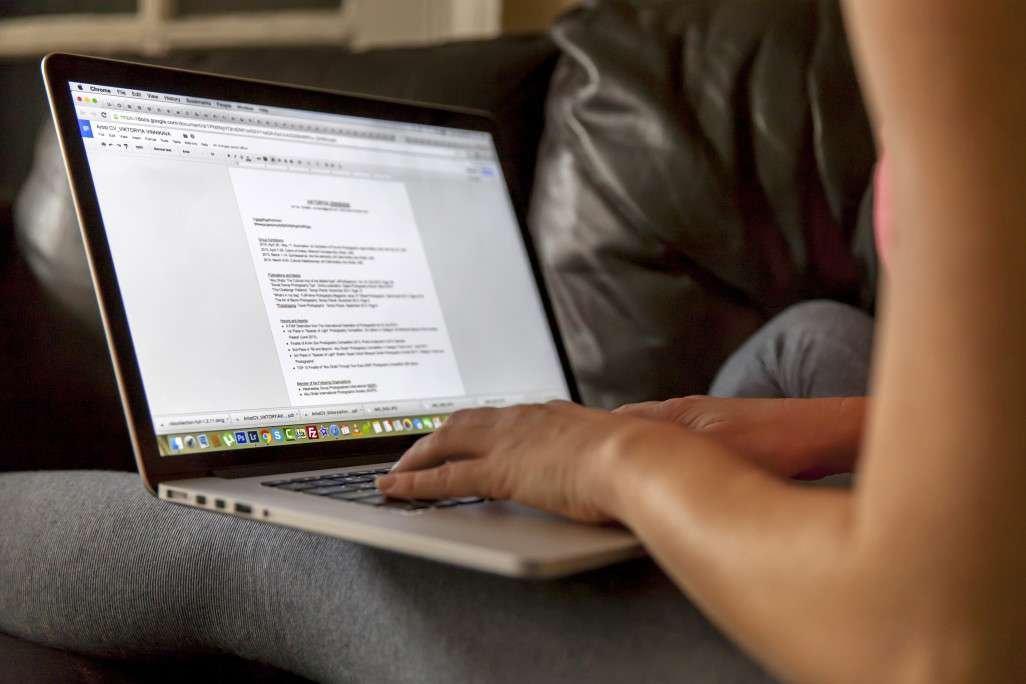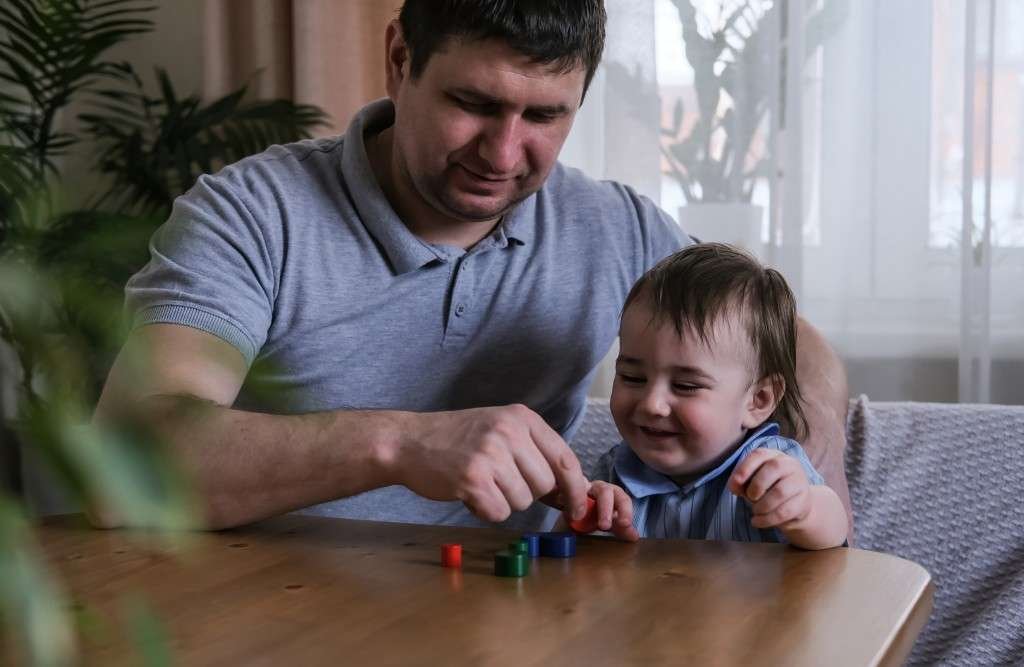Is Typing a Motor Skill?

The answer is yes because you use your hands and fingers to type on a keyboard.
Typing is a motor skill that involves the coordination of many different parts of the body. It requires good eye-hand coordination as well as fine finger dexterity. The muscles involved in typing include those used for moving the arms, shoulders, wrists, elbows, forearms, hands, fingers, thumbs, eyes, neck, head, and mouth.
Typing is also a learned skill. You must practice it regularly to improve your skills. If you are not using a computer daily, you should start now!
What are Motor Skills?

Motor skills are actions or movements that require physical effort. They involve the coordinated movement of various muscle groups. For example, when you ride a bike, you must coordinate your legs, back, arms, shoulders, and even your eyes to keep balance. When you play tennis, you need to coordinate your arm, shoulder, wrist, elbow, hand, and finger movements to swing the racket.
6 Types of Motor Skills

1. Spatial Awareness
Spatial awareness refers to our ability to perceive where things are relative to us. This skill allows us to understand where we are in relation to others and what is happening around us. It helps us navigate space and interact with objects in our environment.
2. Visual Perception
Visual perception is the ability to recognize patterns and shapes. We use this skill to identify objects and their properties. It allows us to distinguish between similar items and to interpret visual clues.
3. Auditory Perception
Auditory perception is the ability to detect sounds and understand speech. We use this skill when listening to music, talking on the phone, or hearing someone speak. It allows us to hear and understand language.
4. Kinesthetic Perception
Kinesthetic perception is the ability to sense movement and touch. We use this skill while walking, running, dancing, and sports. It allows us to feel and respond to stimuli in our bodies.
5. Cognitive Perceptual Skills
Cognitive and perceptual skills refer to our ability to think about how something works. These skills allow us to solve problems by thinking logically and creatively. We use these skills when solving math equations, figuring out how to fix a broken object, or making decisions.
6. Perceptual Integration Skills
Perceptual integration skills are the ability to combine information from multiple senses into one coherent whole. We use these skills to make judgments based on the available sensory data. We use them when deciding whether to eat a particular food, drive a car, or wear a specific outfit.
To learn new skills, you need to be able to observe yourself performing the task. Then, you can analyze your performance and decide if there were any mistakes. Once you’ve identified the areas of weakness, you can work on improving them until they become automatic.
Why is it important to learn how to type?

Typing is an essential skill for today’s workplace. It helps you communicate with others, access information on the Internet, and complete online forms. If you’re not comfortable typing, you may struggle to keep up with technology or even lose out on opportunities.
20 Types of Typing Exercises Tips To Help You Master Typing

1. Touch-typing
Touch typing is the best method to learn how to type fast. This is because you only need to focus on the keys you want to press, not the letters themselves. To touch type, you should practice typing without looking at the keyboard. Once you master this technique, you’ll be able to type faster and more accurately.
2. Visualization
Visualization helps you to memorize the alphabet and the order of the letters. When you visualize something, you imagine it in your mind. Then, you try to remember what you imagined. So, visualization is a great way to improve your memory.
3. Handwriting
Handwriting is an excellent exercise to improve your hand coordination. It is also beneficial to develop fine motor skills.
4. Picking Up Letters
Picking up letters is a great exercise to improve your speed and accuracy. You should pick up the letter from the middle of the page and place it in the top right corner. Repeat this process over and over again.
5. Writing With Your Other Hand
Writing with your other hand improves your handwriting. Start off writing with your dominant hand first. Then, switch to using your non-dominant hand.
6. Learning How to Type Using Computer Keys
Learning how to type using computer keys will help you to type faster. The most common mistake people make when learning to type is looking down at the keyboard instead of focusing on the keys.
7. Practice Makes Perfect
Practice makes perfect. Don’t expect to get better overnight. Instead, start practicing every day. Then, gradually increase the amount of time you spend practicing.
8. Use A Keyboard Trainer
A keyboard trainer software program allows you to practice typing exercises while recording your keystrokes. You can also record your voice as well.
9. Learn From Others
You can learn how to type by watching videos on YouTube or reading books about it. However, you shouldn’t rely solely on video tutorials. Instead, you should read through the reader to understand everything thoroughly.
10. Take Notes While Reading
Taking notes while reading will help you retain the content of the text. You don’t have to write anything down; just take notes by highlighting certain words or phrases.
11. Get Used to the Keyboard Layout
The layout of the keyboard varies depending on the language you speak. For example, the English QWERTY keyboard has letters arranged differently than the French AZERTY keyboard. Therefore, you should familiarize yourself with all the keyboards before typing.
12. Read Books About Typing
Reading typing books will give tips and tricks to improve your typing skills.
13. Play Typing Games
Playing typing games is another way to improve your typing skills quickly. There are many websites where you can play typing games. Some of these sites include https://www.typinggames.zone/ and https://www.typing.com/student/games.
14. Watch Videos On Youtube
Watching videos on youtube will allow you to see different ways of typing. You can watch videos for free online. Search for “how to type” or “learn to type.”
15. Listen To Music While Typing
Listening to music while typing will improve your concentration. You should listen to relaxing music, like instrumental music.
16. Take Breaks
Take breaks in between sessions of typing. This helps you avoid getting tired and frustrated.
17. Choose the Right Font Size
Choose a font size that’s comfortable for you. If you find it difficult to focus on the screen because of the font size, choose a smaller one.
18. Set Goals
Setting goals will motivate you to work harder. Make sure that you set realistic goals. Also, be specific. For example, if you want to learn how to type fast, set a goal such as increasing your typing speed by 10 WPM.
19. Follow Up With Your Goal
Follow up with your goal. Keep track of your progress. This will help you stay motivated and continue working hard.
20. Have Fun!
It’s important to enjoy what you’re doing. So, remember that you’re not here to stress out over something that doesn’t matter.
10 Benefits of Learning How to Type

1. Typing Skills
Typing skills are essential in today’s world. There are many jobs where typing skills are needed. A person who knows how to type well can save time and effort. They can work faster and more efficiently. This means they can earn more money.
2. Self-Esteem
Learning to type helps improve self-esteem. People who learn to type feel good about themselves. They feel proud of their accomplishments. They feel confident in their abilities. They feel better about themselves.
3. Career Advancement
People who learn to type can advance in their careers. They can move up from entry-level positions to higher-paying ones. They can even move into management roles.
4. Job Security
Many jobs require typing skills. Jobs that require typing skills pay well. Many employers prefer hiring employees who already have some experience in this area.
5. Flexibility
Learning to type gives you flexibility if you decide to quit your job. You don’t need to worry about losing your job when you get sick or take a day off.
6. Better Communication
When people communicate using email, text messaging, social media, etc., there is always room for improvement. When people use the proper spelling and grammar, communication becomes much easier.
7. Increased Productivity
When you learn to type, you’ll become more productive at work. You won’t waste time searching for words on the Internet. You’ll spend less time looking things up in dictionaries. Instead, you’ll just press keys on your keyboard.
8. Improved Memory
Learning to type improves memory. It allows you to retain information longer. You’ll remember more facts and figures. You’ll remember phone numbers and addresses.
9. Healthier Lifestyle
Learning to type makes you healthier. It reduces stress levels. It also keeps you active. By learning to type, you’ll burn calories and build muscle mass.
10. More Money
If you know how to type, you can earn more money. You’ll be able to write letters instead of sending emails. You’ll be able to send messages via text instead of calling someone.
The Difference Between Handwriting And Typing

Handwriting and typing are both writing skills. However, they differ in how you write. When you use handwriting, you must think about what you want to say, then write it down. On the other hand, when you type, you just press keys on a keyboard, and words appear on the screen.
Handwriting vs. Typing: What Are The Differences?
Handwriting and typing differ in several ways. Here are three main differences between these two activities.
Difference #1: Speed
One difference between handwriting and typing is speed. When using handwriting, you must think about what you want to say before writing it. Then, you must write it all down. If you make a mistake while writing, you must erase everything and start over again.
On the other hand, when we type, we simply press keys on our keyboards, and words appear on the computer screen. We don’t need to think about what we want to say first. We just type away.
This means that typing is usually faster than handwriting. Some people can type as fast as 120 wpm (words per minute). That’s almost twice as fast as most adults can write.
Difference #2: Accuracy
Another difference between handwriting and typing has to do with accuracy. When using handwriting, you must think about what you want to say before writing it down. If you make an error, you may not notice it until later.
On the other hand, when you type, mistakes are easy to spot. They’re highlighted in red or blue. This helps you correct them quickly.
Difference #3: Flexibility
The third difference between handwriting and typing relates to flexibility. With handwriting, you have to plan. You must consider what you want to say before putting pen to paper.
However, when you type, there’s no planning involved. You can write whatever comes into your head. You can even write something completely different from what you had planned to say.
Biology Behind Typing
Typing is a motor skill, meaning it requires physical effort and coordination. The more we practice typing, the faster our fingers move, and the better we become at it.
But there’s more to typing than just moving your fingers quickly. There’s also a mental component involved. We must be able to concentrate on what we’re typing and not let distractions interfere.
That’s why it’s essential to learn proper keyboarding habits. For instance, we should avoid using the shift key when writing emails because it slows down our typing speed. And when texting, we should use only numbers and letters instead of punctuation marks.
Let’s take a deeper look at the main characteristics that affect your typing skills:
The anatomy of a finger
Finger typing is a skill that most people take for granted. But did you know a lot is happening behind the scenes when you type?
Muscles in your fingers help you type faster and more accurately. These muscles are called intrinsic muscles. They’re located inside the hand and forearm and work together to move your fingers.
When you use these muscles, they contract and relax at different times. This helps you type faster and more efficiently.
But there’s another muscle group that works alongside the intrinsic muscles. The extrinsic muscles are located outside the hand and forearm. They’re responsible for moving your fingers.
These muscles are controlled by nerves originating in the spinal cord and traveling through the brachial plexus. The brachial plexuses are nerve bundles that run along the sides of the neck and shoulder area.
The nerves that control the extrinsic muscles are known as the median, ulnar, radial, and musculocutaneous nerves. Each of these nerves controls a specific function.
The median nerve controls the thumb and index finger. The ulnar nerve controls the pinky and ring finger. The radial nerve controls the middle three fingers. And the musculocutaneous nerve controls the small muscles in the palm.
The muscles involved in typing
Typing involves many different muscles, including those used for wrist flexion (bending), extension (straightening), and pronation (rolling).
When you type, your fingers move back and forth between the home row keys and the other keys. The movement of your fingers causes the muscles in your forearm, wrist, and hand to contract and relax.
Your forearm muscle group includes the biceps brachii, brachialis, brachioradialis, and triceps brachii. Your wrist muscles include the extensor carpi radialis longus, brevis, caput ulnaris, palmaris longus, and flexor carpi radialis. And your hand muscles include the flexors digitorum superficialis, profundus, and intermedius, and the extensors digitorum communis, hallucis longus, lumbricales, opponens pollicis, and abductor pollicis brevis.
As you can see, many muscles are involved in typing. It takes coordination among all of them to produce fast and accurate typing.
The role of the brain
Your brain is responsible for everything you do. Your thoughts, feelings, emotions, memories, and actions are all controlled by your brain.
When you type, your brain sends signals to your fingers via nerves in your hands, arms, shoulders, back, neck, and legs. These nerves send messages to muscles in your fingers, which cause them to move.
This process takes place at lightning speed. The faster you type, the faster your fingers move.
If you’re not careful, typing too fast can lead to carpal tunnel syndrome (CTS). CTS is a painful condition where pressure builds up in the wrist due to overuse. Over time, this pressure causes numbness, tingling, pain, and weakness in the hand and arm.
To avoid CTS, slow down when typing. Take breaks every 30 minutes or so. This gives your wrists a chance to relax and prevents repetitive stress injuries.
Also, use ergonomic keyboards. They help reduce the force required to press keys, making it easier on your wrists.
Finally, try these tips to prevent CTS:
• Use a mouse instead of a keyboard.
• Keep your wrists straight.
• Don’t cross your arms while typing.
• Avoid using a laptop on your lap.
• Sit upright.
The role of practice
Practice makes perfect. Practice makes better. And practice makes fast.
If you’re a beginner at typing, you must practice daily. The more you type, the faster you’ll become.
But there’s another reason to practice every day. Research shows that practicing improves your brain function. Your brain functions better when you use it. So if you want to improve your typing speed, you should practice daily.
And you should practice on a variety of keyboards. Not only does this help you learn how to type on different types of keyboards, but it also helps you develop muscle memory. Muscle memory is the ability to perform tasks automatically.
You form neural pathways in your brain when you practice typing on a keyboard. These pathways allow you to type quickly and accurately.
So practice every day. Use a variety of keyboards. And remember, practice makes perfect.
The role of muscle memory
Muscle memory is the ability to type without thinking about it. This is especially useful when typing fast and accurately because you can type without consciously thinking about each letter.
However, there are times when muscle memory doesn’t work well. For example, when trying to learn a new language, you must consciously think about each character.
Practice makes perfect! That’s where practice comes in handy. The more you practice, the faster you’ll be able to type. So, the next time you learn a new language, try practicing every day until you’ve mastered it.
The role of dexterity
Typing is a skill that requires practice and muscle memory. The more you type, the better you become at typing.
But there’s another reason why we should practice our skills. We need to be able to type fast enough to keep up with the pace of life today.
We constantly connect to email, social media, and online shopping sites. And when we’re not working, we check our phones, tablets, and laptops.
That means we need to be able to quickly tap out messages, emails, tweets, posts, and comments.
And since we spend most of our waking hours sitting down, it makes sense to practice our typing skills.
When you’re ready to improve your typing speed, try these tips:
• Practice typing every day.
• Use a timer to set a goal of typing for a specific time each session.
• Set a daily goal of typing 100 words per minute.
• Choose a comfortable chair and position yourself before a blank computer screen.
• Type slowly and deliberately.
• Don’t rush through your sentences.
The role of touch
Touch typing is a skill that allows you to type faster than you ever thought possible. It’s not just a matter of muscle memory. Touch typing requires practice and concentration.
To learn touch typing, you must recognize letters and words quickly and accurately. The more you practice, the better you become at touch typing.
When you’re learning touch typing, you should try to avoid touching the keyboard. Instead, use a stylus or mouse to tap out each letter. This way, you won’t accidentally hit keys and delete important information.
Once you’ve learned to touch-type, you can speed up your typing speed by practicing these techniques:
• Use the space bar instead of the Enter key.
• Type only the letters you need.
• Don’t press the Shift key when you type.
• Keep your hands away from the keyboard.
• Practice typing in different positions.
The role of feedback
Feedback is essential because it helps us learn. Feedback tells us whether we’re doing things right or wrong. Without feedback, we’d never know if our work was effective or not.
When we receive feedback, we tend to remember it better than when we didn’t receive any. So, feedback makes us smarter.
That’s why feedback is essential to learning. And, it’s vital to improve our typing skills.
If you’ve tried to type faster, you may have noticed that you often make mistakes. Mistakes happen because we aren’t paying enough attention to our actions. We need to pay attention to what we’re typing, so we can correct our errors.
Practice typing every day. To improve your typing speed, you must practice typing. Make sure you use a timer to track how long you spend practicing each day.
Also, try to avoid distractions while you practice. Turn off your phone, close your email program, and turn down the volume on your music player. This way, you won’t be distracted by outside stimuli while practicing.
Finally, set aside some time every week to review your progress. Review your typing speed and accuracy. Then, compare your results to last week’s performance.
You’ll notice that your typing speed improves over time. As you continue to practice, you’ll become a faster typist.
The role of repetition
Repetition is essential when learning any skill. Repetition helps us remember things we learn. We repeat words over and over again until we’ve memorized them.
We use repetition in our language to emphasize certain parts of speech. For example, we say, “He said he’d be there at 5 o’clock.” The phrase “at 5 o’clock” emphasizes that he promised to arrive at 5 p.m.
When learning a new skill, we need to practice it repeatedly until we master it. This is called “practicing.”
Practice makes perfect. So, the next time you practice typing, try repeating a word until you’ve mastered it.
This will help you improve your typing speed and accuracy.
The role of speed
Speed typing is important because it helps you type faster. But you’re not thinking about spelling or grammar when you’re typing fast. So you end up making mistakes.
That’s why it’s important to slow down and proofread your work. Slow typing means slower thoughts, which means better results.
When you’re typing slowly, you can pay closer attention to details like spelling and grammar. This makes you a better writer.
And when you’re a better writer, you’re more likely to produce quality content. Quality content attracts more readers, which leads to more sales.
The role of fatigue
Fatigue is a significant problem for many typists. It causes them to type slower and makes mistakes.
Typing speed depends on several factors, including muscle strength, hand/finger coordination, typing experience, and time spent at the keyboard.
To improve your typing speed, try these tips:
• Practice typing drills.
• Use a timer to measure your typing speed.
• Try different keyboards.
• Take breaks between typing sessions.
• Avoid distractions.
• Get enough sleep.
• Eat healthy foods.
• Exercise regularly.
• Drink plenty of water.
• Use an ergonomic keyboard.
• Don’t sit too long at the computer.
FAQ
Is typing fast a skill?
Typing fast is a skill that requires practice. If you want to become a faster typist, try using different keyboards, such as the Microsoft Natural Ergonomic Keyboard 4000. The keyboard has been designed to help reduce wrist pain and carpal tunnel syndrome.
Is typing an important skill to have?
Typing is one of the most important skills for any business owner, especially when you consider how much time we spend on our computers. If you don’t know how to type, then you’ll need to learn how to use a keyboard and mouse. There are several ways to learn how to type, such as using a computer program like Microsoft Word or learning from YouTube videos.
Is speed typing a very important skill?
Speed typing is a very important skill for any business owner because it helps save time. You may lose money if you spend too much time writing emails or making phone calls. The fastest way to write emails is to use autocomplete. This feature saves you from having to type all the words in the email.
Is typing speed a good indicator of intelligence?
The answer is no! Intelligence has nothing to do with how fast you type. However, some studies show that people who type faster tend to be smarter. This may be due to the fact that when we write, our brain works harder.
Is touch-typing an obsolete skill?
Touch-typing has been replaced by keyboard shortcuts for most tasks. However, some people still prefer to use the mouse instead of the keyboard. If you want to learn how to touch-type again, try typing at least 10 words per minute using only your thumbs.
Is Typing a Motor Skill? Conclusion
In conclusion, typing is a motor skill that everyone should master. Whether using a computer keyboard or a typewriter, learning to type will improve your communication ability, increase productivity, and give you a leg up in the job market. Learning to type means you’ll have a better chance of keeping your job when you inevitably get laid off. Plus, if you’re like most people, you will spend more than half of your waking hours at work.
